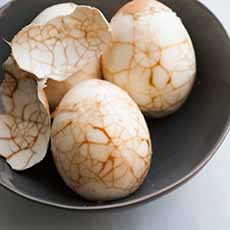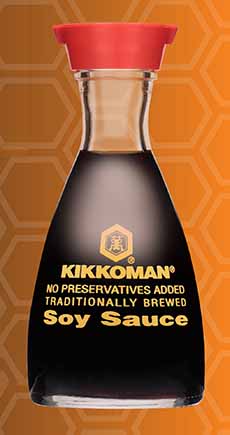Chinese Tea Leaf Eggs Recipe For National Egg Day
|
May 2nd is National Egg Day, and May is National Egg Month. America loves its eggs baked, boiled, deviled, fried, scrambled, and numerous other preparations from frittatas and omelets to custard and quiche. How about Chinese tea leaf eggs, also known as marbled eggs? Chinese Tea Leaf Eggs are a popular Chinese street food which is also known as marbled eggs. Eggs are braised with Chinese teas and spices that have a unique and strong tea flavor. The black tea and soy sauce create a marble pattern when the shells are cracked. The marbled patterns are alluring, as is the aroma from the tea and spices. Enjoy them chilled, room temperature, or warm. Serve them whole, like a hard-boiled egg snack; sliced in quarters to garnish a salad; as an appetizer with chilled seafood; and wherever your culinary creativity leads you. Tea leaf eggs are a traditional lucky food to make for the Lunar New Year, but add pizzazz to meals or snacks the whole year through. You can use different teas—plain black, Earl Grey, jasmine, pu-erh, etc.—and different spices. By the way, these are not Thousand-Year-Old Eggs, cured eggs that are also called Century Eggs, Hundred Year Eggs, Preserved Eggs, and other names. Here’s the scoop about those. > The different types of eggs. When the eggs sit in the broth, the tea and spices are infused into the egg white and yolk. Yummy! Medium eggs are recommended. “If the eggs are too small, they’ll get too rubbery after cooking for a long time,” says Gan Chee How, a supervisor at Tea Chapter, a tea store in Singapore famous for its tea eggs. “Eggs that are too big won’t be able to properly absorb the flavour, so medium-sized eggs are just right” [source]. As a condiment, dip the eggs in soy sauce, which is traditional in China. Or create a fusion dish with Western condiments: hot sauce, mayonnaise, or Chinese or Dijon mustard. We’ve enjoyed them with Thousand Island dressing and other creamy salad dressings. As for beverages: beer, red wine, sparkling wine, and of course, tea or iced tea. Thanks to Kikkoman for the recipe. Ingredients For 8 Servings 1. HARD BOIL the eggs as desired. Submerge the cooked eggs in cold water so that they become cool enough to handle. While eggs cool… 2. WHISK together in a saucepan just large enough to fit the eggs the soy sauce, star anise (or anise seed), black tea leaves, sugar, salt, cinnamon stick, optional Chinese five-spice powder and/or orange zest, and cold water. 3. REMOVE the eggs from the water and pat dry with paper towels. Using the back of a spoon, lightly tap the eggs so that the shell cracks, but not so hard that the shell loosens from the egg. It’s okay if a few tiny pieces of shell break away—the marble tea stain will just be darker in that area. Once the eggshells are covered in cracks… |
|
|
|
4. GENTLY PLACE them in the saucepan with the tea mixture. Once all eggs are in the saucepan, make sure they’re completely submerged in the tea mixture. If not, add more water, up to 1 additional cup. 5. BRING the saucepan to a boil, then reduce to a simmer. Cover and let the eggs simmer for 2 hours (or longer, for a more potent taste), adding more water to the pot as needed to keep the eggs submerged. 6. SERVE: Remove the eggshells. Roll the egg between your palms to loosen the shell, then slip it off. Serve with additional soy sauce for dipping, or use as described above. The tea egg is a savory Chinese preparation commonly sold as a snack by street vendors, convenience stores, or in night markets in most Chinese communities throughout the world, as well as in Asian restaurants. In Southeast Asia, they’re scooped up straight from vats of simmering broth. Tea eggs originated in Zhejiang province* as a way to preserve foods. The earliest written record of tea eggs dates back to 1792, in The Way of Eating by Qing dynasty scholar Yuan Mei [source]. They are now found in all provinces of China. Similar recipes and variations have been developed throughout Asia. ________________ CHECK OUT WHAT’S HAPPENING ON OUR HOME PAGE, THENIBBLE.COM. |
||






